The techniques that novices must know when doing greening projects: A summary of landscaping construction techniques (Part 1)
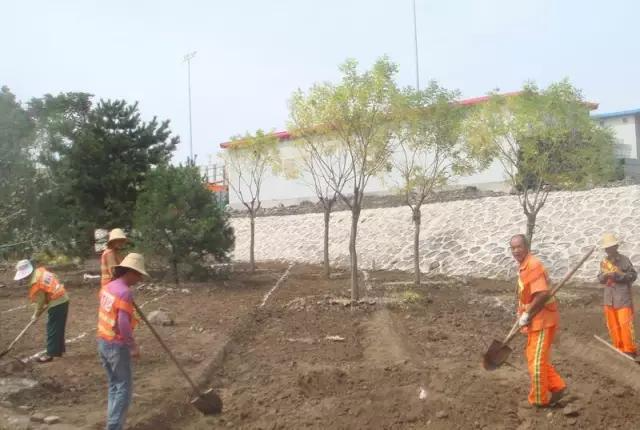
1. Site leveling
1. Before greening construction, the construction site must be leveled and all weeds, stones, debris, silt, etc. in the site must be cleared.
2. If there are concrete plots and hard plots in the construction site, they must be cleared before backfilling with planting soil.
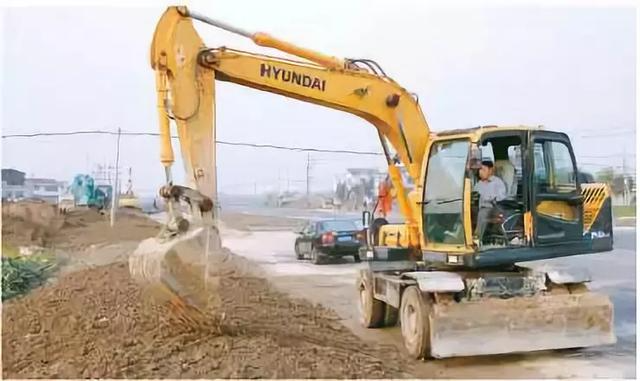
2. Greening filling and shaping
1. When the greening area is filled with thick soil or needs to be piled up to form a mountain, the base should be filled with ordinary soil, and the filling soil should be clay or gravel. It is strictly forbidden to use stones, silt and construction waste for filling.
2. The filling thickness is equal to the design elevation minus the required planting soil thickness, which is equal to the thickness of the filled base soil.
3. When backfilling the base soil, the shaping construction shall be carried out according to the shape and elevation of the design drawings. The shape and coordinate position shall be consistent with the design drawings.
4. When shaping soil mounds or large-scale green areas, as well as laying and leveling planting soil, the overall design elevation should be raised by 3-5 cm.
5. When the base soil is completed, in order to prevent large-scale subsidence in the future, which would result in failure to meet the design elevation, a bulldozer or excavator should be used to compact the entire soil.
6. The planting soil can be backfilled only after the above processes are completed.
7. When leveling the planting soil, the greening land is required to be flat, with natural slopes and curves that are neat and smooth.
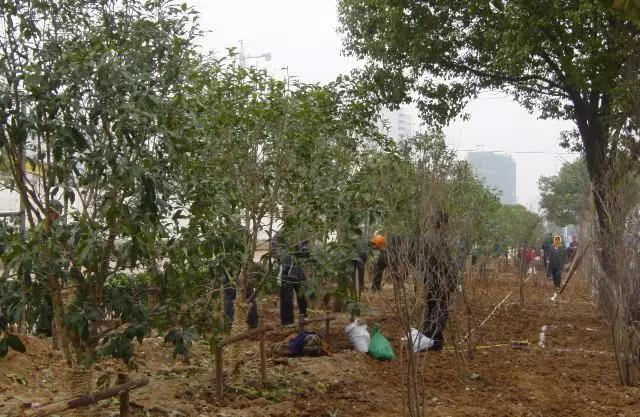
3. Tree and shrub positioning
1. The main tree and shrub planting positioning methods generally use coordinate positioning method, pole positioning method and grid positioning method.
2. The main trees and shrubs in general residential greening, road greening, river greening and general municipal greening are usually positioned using the pole positioning method and the grid positioning method.
3. The coordinate positioning method and grid positioning method are usually used to locate the main trees and shrubs in key greening projects, park construction greening projects and large-scale memorial greening projects.
4. The white lime marking method is generally used to locate ground cover plants and flower plants.
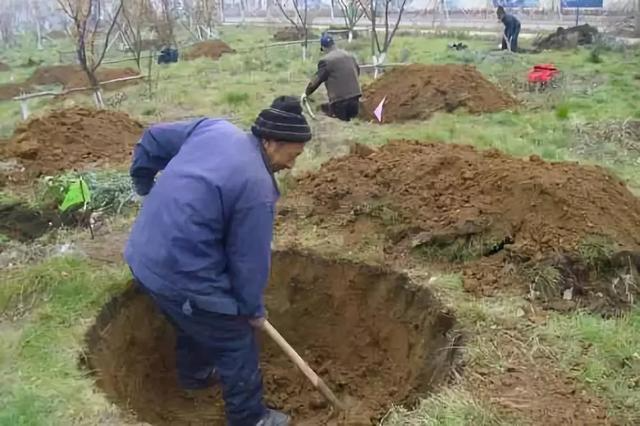
4. Requirements for digging planting holes and grooves
1. Before digging planting trenches or holes, you should inquire about the laying of underground pipelines, communication cables, and hidden objects from relevant units.
2. When locating the planting hole, the center position should be marked, and the planting trough should be marked with the edge line. The marking line should not be bent or broken, and the line must be straight.
3. Fixed-point signs should indicate the name and specifications of the tree species.
4. If you encounter obstacles when locating the tree hole and cannot locate it, you should contact the design unit or relevant responsible leader and make adjustments only after receiving a reply.
5. The size of the planting hole and groove should be determined according to the root system of the seedling and the size of the soil ball. Generally, the diameter of the hole and groove should be 15 cm larger than the diameter of the soil ball, and the depth should be greater than 1/3 of the thickness of the soil ball.
6. When digging holes and trenches, dig vertically and the size of the upper opening and the lower bottom should be equal.
7. After the holes and trenches are dug, organic fertilizer should be added as base fertilizer in the corresponding proportion. The fertilizer should not come into direct contact with the root system and should be covered with planting soil. Note: Unfermented organic fertilizer is prohibited.
8. When locating holes for major landscape trees and large trees, a total station should be used to implement coordinate positioning and digging. For medium-sized trees and shrubs, the grid method and pole insertion method should be used to locate and dig holes.
9. The shape of the tree holes and trenches should be neat and have good appearance.
10. Planting soil should be prepared around the tree holes and troughs, and the required fertilizers, humus soil or fermented organic fertilizers should be mixed in corresponding proportions and set aside.
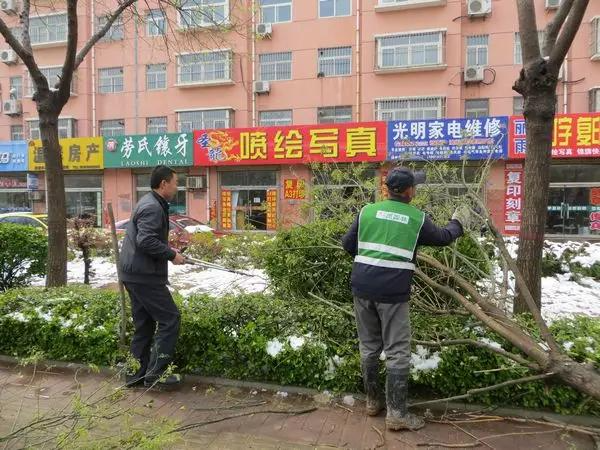
5. Requirements for pruning before planting seedlings
1. The root system of the seedlings should be pruned before planting, and split roots, diseased and insect-infested roots, and excessively long roots should be cut off.
2. Tall deciduous trees with obvious main trunks can be appropriately thinned out while maintaining the original tree shape. The main and side branches that are retained should be cut off at the front end of the strong buds, and 1/5-1/3 of the branches can be cut off.
3. For deciduous trees without obvious main trunks and with dense branches, thinning can be done for trees with a trunk diameter of more than 2 cm, but the original tree shape must be maintained. For seedlings with a trunk diameter of less than 2 cm, several side branches on the main trunk can be selected and pruned to maintain the original tree shape.
4. For evergreen trees with dense branches and round crowns, appropriate amount of pruned branches can be used, and seedlings with branches and leaves clustered at the top of the trunk do not need to be pruned. For evergreen trees with whorled lateral branches, 2-3 layers of whorled lateral branches at the base can be cut off when used as street trees to ensure that the error of the lower edge line of the street tree is within the specified range.
5. For mature tree species, evergreen coniferous trees should not be pruned. Only diseased and insect-infested branches, dead branches, weak branches, broken branches, overly dense whorled branches and drooping branches should be pruned.
6. For trees used as street trees, the trunk height shall not be less than 2.5m. To ensure the trunk height, all branches below the first branching point should be cut off, and branches above the branching point should be thinned out or shortened as appropriate. The original shape of the crown should be maintained, and the error of the lower edge line shall not be greater than 6 centimeters.
7. The crowns of precious tree species should be lightly pruned.
8. For grafted trees and shrubs, the branches that sprout below the interface should be cut off.
9. Small shrubs with obvious branches and new branches bearing flower buds should be pruned appropriately according to their tree vigor to promote the growth of new branches and renew old branches.
10. Trees and shrubs used as hedges can be shaped and pruned according to design requirements after planting. Hedges cultivated in nurseries should be shaped after planting.
11. When pruning seedlings, the cuts must be smooth and neat, and no splits should be allowed.
12. When pruning branches, outer buds should be left and the cut should be at least 0.2 cm away from the bud position.
13. When pruning large and thick branches and roots with a diameter of more than 0.5 cm, the cut must be flattened and coated with preservatives or paint, and then wrapped with a film.
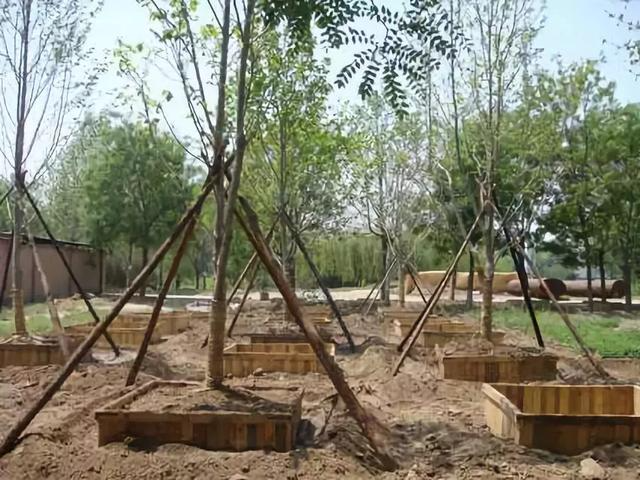
6. Seedling transportation and transplanting
1. The transportation volume of seedlings should be determined according to the planting volume, and the seedlings should be planted in time after arriving at the construction site.
2. When loading and unloading the saplings, they should be lifted and placed gently to avoid damaging them or causing them to scatter. When lifting the saplings, straw ropes or other protective measures should be wrapped around the tree trunks.
3. When lifting small seedlings, the soil ball should be lifted with a rope net. Do not use ropes to tie the root neck for lifting. Large soil balls weighing more than 1 ton should be lifted with a wire mesh on the outside of the soil ball.
4. When loading seedlings, they should be stacked neatly with the soil ball facing forward and the tree crown facing backward according to the direction of the vehicle.
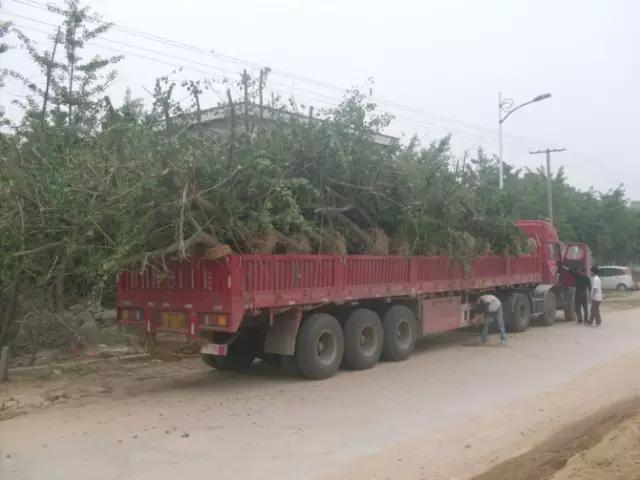
5. When bare-root trees are transported over long distances, the roots should be covered and kept moist, and they should be neatly stacked when loaded. After loading, the trunks should be tied tightly and cushioned to prevent wear of the trunks. If transported for a long time, the roots should be wrapped with cloth with good water absorption and watered every 12 hours.
6. When transporting flowering shrubs, they can be loaded upright and neatly. If they come with soil balls, the soil balls should be wrapped well.
7. When transporting bamboo, the attachment point and whip buds between the bamboo pole and the bamboo whip must not be damaged.
8. All wild seedlings, bare-root seedlings and ground seedlings should be planted using the injection method.
9. All kinds of seedlings entering the site must be planted as soon as possible, and human resources must be strengthened and precisely organized, with full-time planting. If there are indeed seedlings that cannot be planted, they should be neatly placed within a short period of time, covered with shade nets, and watered regularly. Try to keep the seedlings' own moisture from being lost, and it is strictly forbidden to expose the seedlings to the sun. If they cannot be planted for a long time, they should be transplanted, watered regularly, and the leaves and trunks sprayed to maintain the natural moisture of the seedlings.
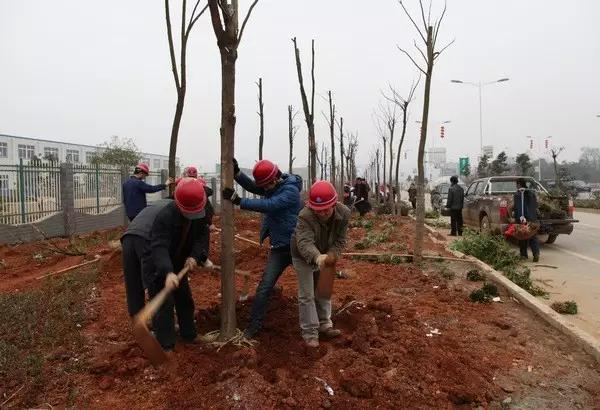
7. Planting of seedlings
1. When planting seedlings, the seedling variety, specifications and planting location should be checked according to the requirements of the design drawings.
2. Regular planting should maintain symmetry and balance. Street trees or row plantings should be in a straight line. Adjacent plants should be reasonably matched in size, with similar heights, trunk diameters, and tree shapes. Planted trees should remain upright and not tilted. Attention should be paid to the reasonable orientation of the viewing surface and the appropriate planting density.
3. When planting hedges, the spacing between rows and plants should be kept uniform, the leaves of full-bodied trees should face outward, and the seedlings should be evenly matched according to their height and trunk size. When planting hedges that have been trimmed into shape in the nursery, they should be planted according to the shape, and the depth and height should be consistent.
4. When planting seedlings, the packaging around the soil ball must be removed.
5. For precious tree species, measures such as crown spraying, trunk moisturizing and rooting hormone spraying should be adopted.
6. For planting holes with poor drainage, gravel with a thickness of more than 3.2 cm should be laid on the bottom of the hole, or drainage measures such as seepage pipes and blind ditches should be laid.
7. After the trees are planted, a water weir should be built around the soil ball. The height of the water weir is 3-4 cm and the diameter is slightly larger than the soil ball. The water weir should be solid and leak-proof, and look good. Fish-scale water weirs can be set up for slope planting.
8. Newly planted seedlings should be watered thoroughly, and all subsequent operations should be carried out in accordance with relevant requirements.
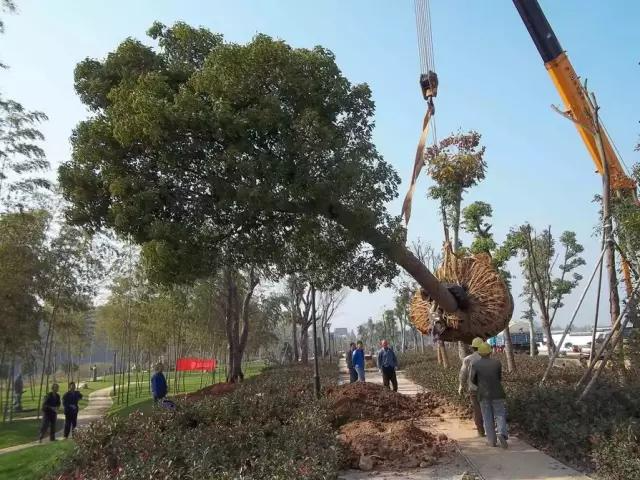
9. When lifting seedlings, experienced workers should be arranged to carry out the tree lifting work, and professional management personnel should be assigned to direct on-site.
10. When the seedlings are lifted and the soil ball is 10 cm off the ground, the operator should move to a corresponding safe distance.
11. When the saplings fall to the ground and enter the tree hole, the operator can enter the working position and stabilize the soil ball when the soil ball is 10 cm off the ground. At this time, the management personnel must observe the saplings from multiple directions and angles, turn the viewing side of the saplings to the corresponding viewing angle, and then stabilize the soil ball and gently drop it into the tree hole.
12. After the soil ball falls into the hole, use a pole to fix the seedlings. After it is stable, you can fill the hole with soil to stabilize the soil ball. The soil should be filled densely, and there should be no gaps around the soil ball.
13. After the soil is backfilled, the suspension rope can be removed and reinforced with iron wire or thin steel rope. (Generally, trees with a diameter of more than 375px need to be reinforced)
14. Every time you plant seedlings or water them, you must spray the crowns and trunks of the seedlings to maintain their natural moisture.
15. The seedlings should be watered thoroughly each time they are planted. A hard pipe about 15 cm long should be installed at the end of the hose. When watering, the hard pipe should be placed around the soil ball at multiple angles and inserted into the lower end of the soil ball to allow natural penetration slowly.
16. After planting trees and shrubs, when entering the ground cover planting, the terrain needs to be reshaped for the second time. Small areas can be dug and leveled manually, and large areas can be dug and leveled with a small 40 or 60 type excavator. The original design requirements of the terrain must be maintained, and the soil must be kept fine and soft.
17. The planting of ground cover seedlings requires a flat surface, good appearance, uniform density, and the planting variety, specifications, density, location, area, quantity, etc. must meet the design requirements.
18. In squares, pavilions, garden paths, piers and all public areas where pedestrian activities are relatively concentrated, the quality of seedlings and construction technology must be maintained.
19. The planting position of the color band must be accurate, the quality of the seedlings must be good, the height of the seedlings must be reasonably matched, the density must be uniform and the soil must not be exposed, the planting technology must be advanced, and the lines must be natural and smooth.
20. Herbaceous flower planting should pay attention to maintenance and protection. After planting, a pergola should be built on it with bamboo poles. In the hot season, it should be covered with a shade net from 11:00 to 18:00 to prevent exposure to the sun. In the cold season, it should be covered with a shade net from 18:00 to 9:00 to prevent frost. In the hot season, the morning should be before 10:00 and the afternoon should be after 17:30. In the cold season, the morning should be after 10:00 and before 17:00. When watering, a nozzle should be added to the end of the leather hose to slowly sprinkle water on the flowers.
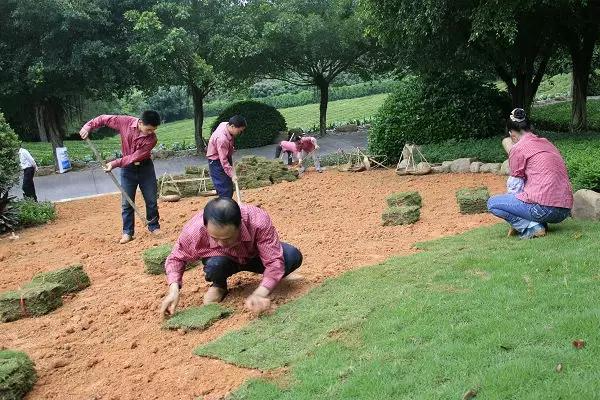
21. When laying the lawn, the site must be flat and detailed. If the soil is hard, it should be dug and leveled; if the site is filled, in order to prevent large-scale subsidence in the future, the soil should be sprinkled with water after leveling, and the turf can be laid after the soil sinks.
22. When laying the lawn, the turf must have a high curling rate and be free of weeds. The large surface must be flat and the joints must be dense and neat.
23. After the large surface of lawn is laid, in order to improve the natural bonding rate between turf and soil, use wooden boards to beat the turf after the first watering to increase its density and flatness.
24. If seeds are to be sown on the lawn, the process can only be carried out after all project processes are completed, and the sowing density must be uniform.
25. The surface soil of the seeded lawn should be relatively fine and flat, without any accumulation of water. The soil should be mixed with organic fertilizer in corresponding proportions. If it is clay soil, the soil should be improved.
26. After sowing the seeds, cover them with non-woven fabric. Cover them evenly and fix them evenly. Do not let them be messed up or blown away by the wind.
27. When laying non-woven fabrics, it is strictly forbidden to step on them randomly. They should be laid from front to back. When watering, it is forbidden to step on them randomly. The lawn should be sprayed evenly and in order. It is forbidden to use a water pipe to spray the lawn directly.
28. When the grass buds grow out, the covering non-woven fabric must be removed. When peeling off the film, the non-woven fabric must not be removed all at once. The wire hook should be pulled out, and the non-woven fabric should be lifted and shaken to make the grass buds ventilated. The non-woven fabric can be completely removed after a week.